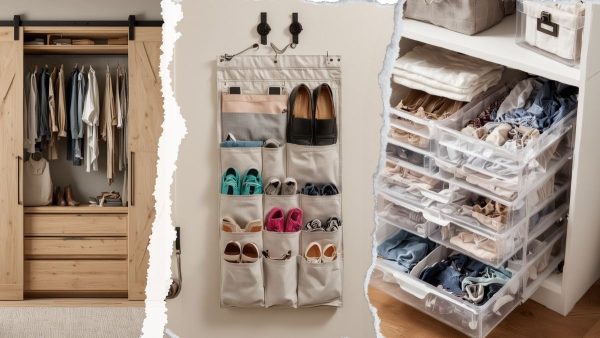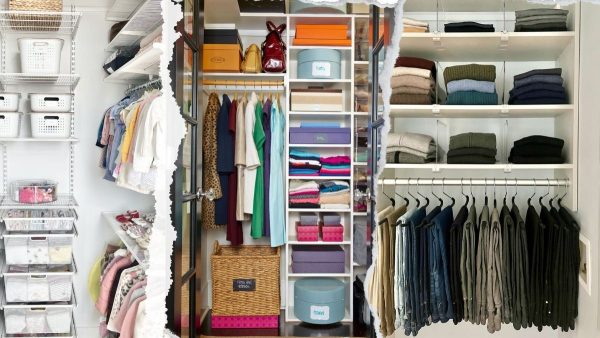Decluttering my closet was one of the best decisions I’ve ever made. Not only did I find clothes I had forgotten about, but I also created a more organized and peaceful space.

In this article, I’ll share practical steps to help you streamline your wardrobe, and make your closet a place of order & tranquility.
Let’s begin!
1. Empty and Clean
You should start by completely emptying your closet and removing all clothes, shoes, and accessories.
This gives you a clean slate and allows you to deep clean the space. Dust shelves, wipe surfaces, and vacuum or sweep the floor.
Cleaning the space thoroughly not only makes it easier to assess what you have but also creates a more inviting environment to organize your items.
2. Sort by Category
Organize your items into broad categories like tops, bottoms, dresses, outerwear, and accessories.
Within each category, further sort by subcategories such as casual, formal, and seasonal wear.
This method helps you better understand the volume of each type of clothing you own, identify duplicates, and see which items you use most frequently.
It also makes the decluttering process more manageable and efficient by breaking it down into smaller tasks.
3. Ask Key Questions
As you go through each item, ask yourself if you wear it, if it fits, if it’s in good condition, and if you love it.
These questions help you make objective decisions about what to keep. If you haven’t worn something in the past year, it’s likely time to let it go.
This approach ensures that your closet only contains useful items, that fit well, and make you feel good, helping to reduce clutter and improve your daily dressing experience.
4. Create Piles
Make separate piles for items to keep, donate, sell, or trash. This system helps you stay organized and focused during the decluttering process.
On the other hand, for items you’re unsure about, consider a “maybe” pile to revisit at the end.
This method streamlines decision-making and ensures that each item has a designated outcome, reducing the chance of keeping unnecessary clutter.
Once sorted, immediately deal with each pile to prevent second-guessing your decisions.
5. Use Appropriate Storage Solutions
Invest in proper storage solutions like slim, non-slip hangers, clear bins for shoes, drawer dividers, and shelf dividers. These tools help keep different items organized and accessible.
For example, velvet hangers can prevent delicate items from slipping, while clear bins allow you to see shoes at a glance.
These solutions maximize your closet space and make it easier to maintain an organized and clutter-free environment.
6. Implement the Reverse Hanger Technique
Hang all your clothes with the hangers facing backward. When you wear and wash an item, return it with the hanger facing the correct way.
After a few months, this technique makes it clear which clothes you haven’t worn, making it easier to decide what to discard.
This method provides a visual cue to help you identify items that are not being used and can be a powerful tool for regular decluttering sessions.
7. One In, One Out Rule
For every new item you bring into your closet, remove one. This rule helps prevent overcrowding and encourages thoughtful purchasing.
It maintains balance in your wardrobe by ensuring that your closet only contains items you actively use and love.
By sticking to this practice, you avoid accumulating unnecessary items and keep your closet organized and manageable over time.
8. Store Seasonal Items Separately
Keep out-of-season clothes in labeled bins or under-the-bed storage to free up closet space. Rotate your wardrobe as seasons change, ensuring your closet only holds what you currently need.
This approach not only saves space but also makes it easier to find and access the clothes you wear regularly.
Properly storing seasonal items also protects them from damage and keeps them in good condition for the next use.
9. Regular Decluttering
Schedule regular decluttering sessions, such as every few months or at the start of each season.
This habit keeps your closet manageable and prevents clutter from building up again.
Regular assessments allow you to continually refine your wardrobe, ensuring it stays functional and filled with items that you love and use.
10. Custom Organization
Customize your closet to fit your specific needs. This could involve adding shelves, adjusting rod heights, or using different types of storage solutions.
Tailoring your closet to your wardrobe makes it more functional and easier to maintain. For example, if you have a lot of shoes, consider adding extra shelving or a shoe rack.
A personalized setup ensures that every item has its place, making daily use more convenient and keeping your closet clutter-free.

